Analysis of LULC and Urban Thermal Variations in Industrial Cities Using Earth Observation Indices and Machine Learning: A Case Study of Gujranwala, Pakistan
Abstract
1. Introduction
2. Study Area
3. Methodology
3.1. Data Acquisition and Preprocessing
3.2. LULC Classification, Validation, and Changes
3.2.1. Calculation of EOIs
- NIR (Near-Infrared): Band 4 for Landsat-5 and -7; Band 5 for Landsat-8.
- Red: Band 3 for Landsat-5 and -7; Band 4 for Landsat-8.
- Blue: Band 2 for Landsat-5 and -7; Band 3 for Landsat-8.
- Green: Band 1 for Landsat-5 and -7; Band 2 for Landsat-8.
- SWIR1 (Shortwave Infrared 1): Band 5 for Landsat-5 and -7; Band 6 for Landsat-8.
- SWIR2 (Shortwave Infrared 2): Landsat-5, -7, and -8: Band 7.
3.2.2. Classification of LULC
3.2.3. LULC Classes Validation
3.2.4. LULC Change Analysis
3.3. Calculation of Thermal Indices (LST, UHI, and UTFVI)
3.3.1. NDVI and Fraction Vegetation (FV) Calculations
- NDVI = Normalized Difference Vegetation Index for a given pixel.
- NDVImin = Lowest NDVI (typically indicative of bare areas or areas without vegetation).
- NDVImax = Highest NDVI (usually representing areas of dense vegetation).
3.3.2. Land Surface Emissivity (ε) Calculation
- ε is the land surface emissivity (unitless, ranging from 0 to 1).
- FV is fraction vegetation (unitless, ranging from 0 to 1).
- 0.004 and 0.986 are constants based on empirical studies.
3.3.3. Conversion of Digital Numbers (DN) to LST
- Lmaxλ is the highest value of spectral radiance.
- Lminλ is the lowest value of spectral radiance.
- QCALmax is the maximum quantized calibrated pixel value (associated with Lmaxλ with a DN value of 255).
- QCALmin signifies the minimum quantized calibrated pixel value (linked to Lminλ with a DN value of 1).
- TB is the brightness temperature (BT) in Kelvin units.
- K1 and K2 represent thermal constants offered by the USGS.
- TS represents the per-pixel LST value.
- λ is the wavelength of emitted radiance (11.5 µM).
- ρ is 1.438 × 10−2mk.
- ε represents the land surface emissivity.
3.3.4. Calculation of UHI
- TS represents the LST value for each pixel.
- Tmean represents mean LST throughout the study area.
- Tstd represents the standard deviation of LST within the study area.
3.3.5. Calculation of UTFVI
- Ts = LST of a specific pixel, and Tm = mean LST of the study area.
3.4. Machine Learning Models for LULC and UTFVI Simulation
3.4.1. Analysis of Pearson’s Correlation Coefficient (PCC) for EOIs, LULC, and Thermal Indices
3.4.2. LULC and UTFVI Simulation
- PK→u is the probability of transition from class k to u.
- xi represents the input drivers.
- ωij and ωj are learned weights.
- Φ is the ReLU hidden layer activation.
- σ is the Softmax output activation.
3.4.3. Accuracy Evaluation and Model Validation
3.5. Variations in UTFVI Across LULC
3.6. Gradient Directional Analysis (GDA) for Spatial Patterns
4. Results
4.1. LULC Classification and Change Detection
4.1.1. LULC Classification and Validation
4.1.2. LULC Change Detection (2001–2021)
4.2. Urban Thermal Variations
4.2.1. Temporal Trends in LST
4.2.2. UTFVI and Change Detection
4.3. Future Projection of LULC and UTFVI Using the CA-ANN Model
4.3.1. PCC Analysis
4.3.2. LULC Projection
4.3.3. UTFVI Projection
4.4. UTFVI Variations Across Different LULC Classes
4.5. Directional Analysis of LULC and UTFVI
4.5.1. GDA of LULC (2001–2041)
4.5.2. GDA of UTFVI (2001–2041)
5. Discussion
6. Conclusions, Limitations, and Future Work
Author Contributions
Funding
Data Availability Statement
Conflicts of Interest
References
- Guo, A.; He, T.; Yue, W.; Xiao, W.; Yang, J.; Zhang, M.; Li, M. Contribution of Urban Trees in Reducing Land Surface Temperature: Evidence from China’s Major Cities. Int. J. Appl. Earth Obs. Geoinf. 2023, 125, 103570. [Google Scholar] [CrossRef]
- Cui, J.; Ji, W.; Wang, P.; Zhu, M.; Liu, Y. Spatial–Temporal Changes in Land Use and Their Driving Forces in the Circum-Bohai Coastal Zone of China from 2000 to 2020. Remote Sens. 2023, 15, 2372. [Google Scholar] [CrossRef]
- Talukdar, S.; Singha, P.; Mahato, S.; Shahfahad; Pal, S.; Liou, Y.-A.; Rahman, A. Land-Use Land-Cover Classification by Machine Learning Classifiers for Satellite Observations—A Review. Remote Sens. 2020, 12, 1135. [Google Scholar] [CrossRef]
- Kafy, A.-A.; Saha, M.; Faisal, A.A.; Rahaman, Z.A.; Rahman, M.T.; Liu, D.; Fattah, M.A.; Al Rakib, A.; AlDousari, A.E.; Rahaman, S.N.; et al. Predicting the Impacts of Land Use/Land Cover Changes on Seasonal Urban Thermal Characteristics Using Machine Learning Algorithms. Build. Environ. 2022, 217, 109066. [Google Scholar] [CrossRef]
- Ge, W.; Deng, L.; Wang, F.; Han, J. Quantifying the Contributions of Human Activities and Climate Change to Vegetation Net Primary Productivity Dynamics in China from 2001 to 2016. Sci. Total Environ. 2021, 773, 145648. [Google Scholar] [CrossRef]
- Luo, Y.; Sun, W.; Yang, K.; Zhao, L. China Urbanization Process Induced Vegetation Degradation and Improvement in Recent 20 Years. Cities 2021, 114, 103207. [Google Scholar] [CrossRef]
- Wang, Z.; Ishida, Y.; Mochida, A. Effective Factors for Reducing Land Surface Temperature in Each Local Climate Zone Built Type in Tokyo and Shanghai. Remote Sens. 2023, 15, 3840. [Google Scholar] [CrossRef]
- Rasool, R.; Fayaz, A.; Shafiq, M.U.; Singh, H.; Ahmed, P. Land Use Land Cover Change in Kashmir Himalaya: Linking Remote Sensing with an Indicator Based DPSIR Approach. Ecol. Indic. 2021, 125, 107447. [Google Scholar] [CrossRef]
- Miller, J.D.; Hutchins, M. The Impacts of Urbanisation and Climate Change on Urban Flooding and Urban Water Quality: A Review of the Evidence Concerning the United Kingdom. J. Hydrol. Reg. Stud. 2017, 12, 345–362. [Google Scholar] [CrossRef]
- Stewart, K. Atmospheric Attunements. Environ. Plan. D 2011, 29, 445–453. [Google Scholar] [CrossRef]
- Guo, A.; Yang, J.; Xiao, X.; Xia, J.; Jin, C.; Li, X. Influences of Urban Spatial Form on Urban Heat Island Effects at the Community Level in China. Sustain. Cities Soc. 2020, 53, 101972. [Google Scholar] [CrossRef]
- Qian, Y.; Chakraborty, T.C.; Li, J.; Li, D.; He, C.; Sarangi, C.; Chen, F.; Yang, X.; Leung, L.R. Urbanization Impact on Regional Climate and Extreme Weather: Current Understanding, Uncertainties, and Future Research Directions. Adv. Atmos. Sci. 2022, 39, 819–860. [Google Scholar] [CrossRef]
- Kazemi, A.; Cirella, G.T.; Hedayatiaghmashhadi, A.; Gili, M. Temporal-Spatial Distribution of Surface Urban Heat Island and Urban Pollution Island in an Industrial City: Seasonal Analysis. IEEE J. Sel. Top. Appl. Earth Obs. Remote Sens. 2025, 18, 7100–7116. [Google Scholar] [CrossRef]
- Luo, Z.; Shao, Q.; Zuo, Q.; Cui, Y. Impact of Land Use and Urbanization on River Water Quality and Ecology in a Dam Dominated Basin. J. Hydrol. 2020, 584, 124655. [Google Scholar] [CrossRef]
- Portela, C.I.; Massi, K.G.; Rodrigues, T.; Alcântara, E. Impact of Urban and Industrial Features on Land Surface Temperature: Evidences from Satellite Thermal Indices. Sustain. Cities Soc. 2020, 56, 102100. [Google Scholar] [CrossRef]
- Soydan, O. Effects of Landscape Composition and Patterns on Land Surface Temperature: Urban Heat Island Case Study for Nigde, Turkey. Urban. Clim. 2020, 34, 100688. [Google Scholar] [CrossRef]
- Liu, S.; Zhang, J.; Li, J.; Li, Y.; Zhang, J.; Wu, X. Simulating and Mitigating Extreme Urban Heat Island Effects in a Factory Area Based on Machine Learning. Build. Environ. 2021, 202, 108051. [Google Scholar] [CrossRef]
- Chow, W.T.L.; Brennan, D.; Brazel, A.J. Urban Heat Island Research in Phoenix, Arizona: Theoretical Contributions and Policy Applications. Bull. Am. Meteorol. Soc. 2012, 93, 517–530. [Google Scholar] [CrossRef]
- He, B.-J. Potentials of Meteorological Characteristics and Synoptic Conditions to Mitigate Urban Heat Island Effects. Urban. Clim. 2018, 24, 26–33. [Google Scholar] [CrossRef]
- Halder, B.; Bandyopadhyay, J. Evaluating the Impact of Climate Change on Urban Environment Using Geospatial Technologies in the Planning Area of Bilaspur, India. Environ. Chall. 2021, 5, 100286. [Google Scholar] [CrossRef]
- Shahfahad; Talukdar, S.; Rihan, M.; Hang, H.T.; Bhaskaran, S.; Rahman, A. Modelling Urban Heat Island (UHI) and Thermal Field Variation and Their Relationship with Land Use Indices over Delhi and Mumbai Metro Cities. Environ. Dev. Sustain. 2022, 24, 3762–3790. [Google Scholar] [CrossRef]
- Venkatraman, S.; Kandasamy, V.; Rajalakshmi, J.; Sabarunisha Begum, S.; Sujatha, M. Assessment of Urban Heat Island Using Remote Sensing and Geospatial Application: A Case Study in Sao Paulo City, Brazil, South America. J. South. Am. Earth Sci. 2024, 134, 104763. [Google Scholar] [CrossRef]
- Derdouri, A.; Wang, R.; Murayama, Y.; Osaragi, T. Understanding the Links between LULC Changes and SUHI in Cities: Insights from Two-Decadal Studies (2001–2020). Remote Sens. 2021, 13, 3654. [Google Scholar] [CrossRef]
- Guha, S.; Govil, H. Annual Assessment on the Relationship between Land Surface Temperature and Six Remote Sensing Indices Using Landsat Data from 1988 to 2019. Geocarto Int. 2022, 37, 4292–4311. [Google Scholar] [CrossRef]
- Mallick, S.K.; Rudra, S. Land Use Changes and Its Impact on Biophysical Environment: Study on a River Bank. Egypt. J. Remote Sens. Space Sci. 2021, 24, 1037–1049. [Google Scholar] [CrossRef]
- Addas, A. Understanding the Relationship between Urban Biophysical Composition and Land Surface Temperature in a Hot Desert Megacity (Saudi Arabia). Int. J. Environ. Res. Public Health 2023, 20, 5025. [Google Scholar] [CrossRef]
- Kumar Gavsker, K. Urban Growth, Changing Relationship between Biophysical Factors and Surface Thermal Characteristics: A Geospatial Analysis of Agra City, India. Sustain. Cities Soc. 2023, 94, 104542. [Google Scholar] [CrossRef]
- Ali, M.B.; Jamal, S.; Ahmad, M.; Saqib, M. Unriddle the Complex Associations among Urban Green Cover, Built-up Index, and Surface Temperature Using Geospatial Approach: A Micro-Level Study of Kolkata Municipal Corporation for Sustainable City. Theor. Appl. Clim. 2024, 155, 4139–4160. [Google Scholar] [CrossRef]
- Shamsudeen, M.; Padmanaban, R.; Cabral, P.; Morgado, P. Spatio-Temporal Analysis of the Impact of Landscape Changes on Vegetation and Land Surface Temperature over Tamil Nadu. Earth 2022, 3, 614–638. [Google Scholar] [CrossRef]
- Jamei, Y.; Seyedmahmoudian, M.; Jamei, E.; Horan, B.; Mekhilef, S.; Stojcevski, A. Investigating the Relationship between Land Use/Land Cover Change and Land Surface Temperature Using Google Earth Engine; Case Study: Melbourne, Australia. Sustainability 2022, 14, 14868. [Google Scholar] [CrossRef]
- Roy, B.; Bari, E. Examining the Relationship between Land Surface Temperature and Landscape Features Using Spectral Indices with Google Earth Engine. Heliyon 2022, 8, e10668. [Google Scholar] [CrossRef]
- Mazhar, F.; Fadia, F. A Time Series Analysis of Satellite Imageries for Land Use & Land Cover (LULC) Change Detection of Gujranwala City, Pakistan from 1999–2019. Indian J. Sci. Technol. 2019, 12, 1–9. [Google Scholar] [CrossRef]
- Khan, M.; Qasim, M.; Ahmad, A.; Tahir, A.A.; Farooqi, A. Predicting Land Use Dynamics, Surface Temperature and Urban Thermal Field Variance Index in Mild Cold Climate Urban Area of Pakistan. Heliyon 2024, 10, e38787. [Google Scholar] [CrossRef] [PubMed]
- Mehmood, M.S.; Zafar, Z.; Sajjad, M.; Hussain, S.; Zhai, S.; Qin, Y. Time Series Analyses and Forecasting of Surface Urban Heat Island Intensity Using ARIMA Model in Punjab, Pakistan. Land 2023, 12, 142. [Google Scholar] [CrossRef]
- Li, S.; Yang, X.; Cui, P.; Sun, Y.; Song, B. Machine-Learning-Algorithm-Based Prediction of Land Use/Land Cover and Land Surface Temperature Changes to Characterize the Surface Urban Heat Island Phenomena over Harbin, China. Land 2024, 13, 1164. [Google Scholar] [CrossRef]
- Singgalen, Y.A. Spatio-Temporal Analysis through NDVI, NDBI, and SAVI Using Landsat 8/9 OLI. J. Comput. Syst. Inform. 2024, 5, 815–831. [Google Scholar] [CrossRef]
- Dapke, P.P.; Nagare, S.M.; Quadri, S.A.; Bandal, S.B.; Gaikwad, R.M.; Baheti, M.R. Seasonal Analysis of Vegetation, Moisture, Urbanization, and Land Surface Temperature (LST) Using NDVI, NDMI, NDWI, and NDBI Indices: A Case Study of Sillod, Maharashtra. In Proceedings of the 2025 International Conference on Computational, Communication and Information Technology (ICCCIT), Indore, India, 7 February 2025; pp. 753–760. [Google Scholar]
- Giachino, C.; Bollani, L.; Truant, E.; Bonadonna, A. Urban Area and Nature-Based Solution: Is This an Attractive Solution for Generation Z? Land Use Policy 2022, 112, 105828. [Google Scholar] [CrossRef]
- Kafy, A.; MA, I.; Khan, M.H.H.; Sarker, M.H.S.; Rahman, M.W. Prediction of Future Land Surface Temperature and Its Impact on Climate Change: A Remote Sensing Based Approach In Chattogram City. In Proceedings of the 1st International Student Research Conference–2020, Dhaka, Bangladesh, 1 April 2020; pp. 1–12. [Google Scholar]
- Uqaili Abdul, A.; Zafar, D.R.; Naeem, U.Z.; Bahrawar, J.; Muhammad, S.; Aisha, S.; Muhammad, S.; Shakeel, Q.; Fazal, A.S. Pakistan Statistical Year Book 2020; Pakistan Bureau of Statistics Govt of Pakistan: Islamabad, Pakistan, 2020; pp. 1–507.
- Minallah, M.N.; Ghaffar, A.; Rafique, M.; Mohsin, M. Urban Growth and Socio-Economic Development in Gujranwala, Pakistan: A Geographical Analysis. Pak. J. Sci. 2016, 68, 176–183. [Google Scholar] [CrossRef]
- Gondal, M.S.; Ayazuddin; Sandhu, A.J.; Awan, R. 7th Population & Housing Census “First Ever Digital Census” Key Findings Report The Largest Digitization Exercise of South Asia; Government of Pakistan, Ministry of Planning Development and Special Initiatives, Pakistan Bureau of Statistics, Statistics House: Islamabad, Pakistan, 2023.
- Roy, D.P.; Wulder, M.A.; Loveland, T.R.; Woodcock, C.E.; Allen, R.G.; Anderson, M.C.; Helder, D.; Irons, J.R.; Johnson, D.M.; Kennedy, R.; et al. Landsat-8: Science and Product Vision for Terrestrial Global Change Research. Remote Sens. Environ. 2014, 145, 154–172. [Google Scholar] [CrossRef]
- Phan, T.N.; Kuch, V.; Lehnert, L.W. Land Cover Classification Using Google Earth Engine and Random Forest Classifier—The Role of Image Composition. Remote Sens. 2020, 12, 2411. [Google Scholar] [CrossRef]
- Xu, H. Modification of Normalised Difference Water Index (NDWI) to Enhance Open Water Features in Remotely Sensed Imagery. Int. J. Remote Sens. 2006, 27, 3025–3033. [Google Scholar] [CrossRef]
- Rouse, J.W.; Haas, R.H.; Schell, J.A.; Deering, D.W. Monitoring the Vernal Advancement and Retrogradation (Green Wave Effect) of Natural Vegetation; NASA: Washington, DC, USA, 1973; pp. 1–120. [Google Scholar]
- Huete, A.; Didan, K.; Miura, T.; Rodriguez, E.P.; Gao, X.; Ferreira, L.G. Overview of the Radiometric and Biophysical Performance of the MODIS Vegetation Indices. Remote Sens. Environ. 2002, 83, 195–213. [Google Scholar] [CrossRef]
- Zha, Y.; Gao, J.; Ni, S. Use of Normalized Difference Built-up Index in Automatically Mapping Urban Areas from TM Imagery. Int. J. Remote Sens. 2003, 24, 583–594. [Google Scholar] [CrossRef]
- Gao, B. NDWI—A Normalized Difference Water Index for Remote Sensing of Vegetation Liquid Water from Space. Remote Sens. Environ. 1996, 58, 257–266. [Google Scholar] [CrossRef]
- McFeeters, S.K. The Use of the Normalized Difference Water Index (NDWI) in the Delineation of Open Water Features. Int. J. Remote Sens. 1996, 17, 1425–1432. [Google Scholar] [CrossRef]
- Amini, S.; Saber, M.; Rabiei-Dastjerdi, H.; Homayouni, S. Urban Land Use and Land Cover Change Analysis Using Random Forest Classification of Landsat Time Series. Remote Sens. 2022, 14, 2654. [Google Scholar] [CrossRef]
- Belgiu, M.; Drăguţ, L. Random Forest in Remote Sensing: A Review of Applications and Future Directions. ISPRS J. Photogramm. Remote Sens. 2016, 114, 24–31. [Google Scholar] [CrossRef]
- Gorelick, N.; Hancher, M.; Dixon, M.; Ilyushchenko, S.; Thau, D.; Moore, R. Google Earth Engine: Planetary-Scale Geospatial Analysis for Everyone. Remote Sens. Environ. 2017, 202, 18–27. [Google Scholar] [CrossRef]
- Papoutsis, I.; Bountos, N.I.; Zavras, A.; Michail, D.; Tryfonopoulos, C. Benchmarking and Scaling of Deep Learning Models for Land Cover Image Classification. ISPRS J. Photogramm. Remote Sens. 2023, 195, 250–268. [Google Scholar] [CrossRef]
- Corcoran, J.; Knight, J.; Pelletier, K.; Rampi, L.; Wang, Y. The Effects of Point or Polygon Based Training Data on RandomForest Classification Accuracy of Wetlands. Remote Sens. 2015, 7, 4002–4025. [Google Scholar] [CrossRef]
- Hu, J.; Liu, J.; Li, Z.; Zhu, J.; Wu, L.; Sun, Q.; Wu, W. Estimating Three-Dimensional Coseismic Deformations with the SM-VCE Method Based on Heterogeneous SAR Observations: Selection of Homogeneous Points and Analysis of Observation Combinations. Remote Sens. Environ. 2021, 255, 112298. [Google Scholar] [CrossRef]
- Congalton, R.G.; Green, K. Assessing the Accuracy of Remotely Sensed Data; CRC Press: Boca Raton, FL, USA, 2019; ISBN 9780429052729. [Google Scholar]
- Tewabe, D.; Fentahun, T. Assessing Land Use and Land Cover Change Detection Using Remote Sensing in the Lake Tana Basin, Northwest Ethiopia. Cogent Environ. Sci. 2020, 6, 1778998. [Google Scholar] [CrossRef]
- Xiong, Y.; Xu, W.; Lu, N.; Huang, S.; Wu, C.; Wang, L.; Dai, F.; Kou, W. Assessment of Spatial–Temporal Changes of Ecological Environment Quality Based on RSEI and GEE: A Case Study in Erhai Lake Basin, Yunnan Province, China. Ecol. Indic. 2021, 125, 107518. [Google Scholar] [CrossRef]
- Zhou, D.; Zhao, S.; Zhang, L.; Sun, G.; Liu, Y. The Footprint of Urban Heat Island Effect in China. Sci. Rep. 2015, 5, 11160. [Google Scholar] [CrossRef] [PubMed]
- Weng, Q.; Lu, D.; Schubring, J. Estimation of Land Surface Temperature–Vegetation Abundance Relationship for Urban Heat Island Studies. Remote Sens. Environ. 2004, 89, 467–483. [Google Scholar] [CrossRef]
- Sobrino, J.A.; Jiménez-Muñoz, J.C.; Paolini, L. Land Surface Temperature Retrieval from LANDSAT TM 5. Remote Sens. Environ. 2004, 90, 434–440. [Google Scholar] [CrossRef]
- Avdan, U.; Jovanovska, G. Algorithm for Automated Mapping of Land Surface Temperature Using LANDSAT 8 Satellite Data. J. Sens. 2016, 2016, 1–8. [Google Scholar] [CrossRef]
- Chen, J.; Zhan, W.; Du, P.; Li, L.; Li, J.; Liu, Z.; Huang, F.; Lai, J.; Xia, J. Seasonally Disparate Responses of Surface Thermal Environment to 2D/3D Urban Morphology. Build. Environ. 2022, 214, 108928. [Google Scholar] [CrossRef]
- Liu, L.; Zhang, Y. Urban Heat Island Analysis Using the Landsat TM Data and ASTER Data: A Case Study in Hong Kong. Remote Sens. 2011, 3, 1535–1552. [Google Scholar] [CrossRef]
- Pande, C.B.; Egbueri, J.C.; Costache, R.; Sidek, L.M.; Wang, Q.; Alshehri, F.; Din, N.M.; Gautam, V.K.; Chandra Pal, S. Predictive Modeling of Land Surface Temperature (LST) Based on Landsat-8 Satellite Data and Machine Learning Models for Sustainable Development. J. Clean. Prod. 2024, 444, 141035. [Google Scholar] [CrossRef]
- Abu Yousuf, M.A.; Masrur, A.; Adnan, M.S.G.; Baky, M.A.A.; Hassan, Q.K.; Dewan, A. Spatio-Temporal Patterns of Land Use/Land Cover Change in the Heterogeneous Coastal Region of Bangladesh between 1990 and 2017. Remote Sens. 2019, 11, 790. [Google Scholar] [CrossRef]
- Wang, A.; Zhang, M.; Ren, B.; Zhang, Y.; Al Kafy, A.-; Li, J. Ventilation Analysis of Urban Functional Zoning Based on Circuit Model in Guangzhou in Winter, China. Urban. Clim. 2023, 47, 101385. [Google Scholar] [CrossRef]
- Khwaja, M.A. Environmental Challenges and Constraints to Policy Issues for Sustainable Industrial Development in Pakistan. 2012. Available online: https://d1wqtxts1xzle7.cloudfront.net/74392398/Environmental_Challenges_and_Constraints20211108-11027-o0169o.pdf?1738447655=&response-content-disposition=inline%3B+filename%3DEnvironmental_Challenges_and_Constraints.pdf&Expires=1752578623&Signature=cd-M~EVZB3pGLxdjNbsHHImxe31vGEYql4KflbMVXc~AaJg0YpJnsnAz8nXt92OD74KzWDXu2D0dZhjF6S28VxUpLkWp1OGqkNt4xgw7DCqmFaAYUXHej9-3kh3ohN4BC1jemeAKtVPOpHD~hLLVsslxNm1beK5Mx3szgffRTNdREAuaS1OnYxXcFirP0RbQnIYWpdH3aQpKYcXbkN~q99D9fx8VFDn549gumhhGhdDhuhoNTxeg7zdprLc53xoiLWhrPLgL21wowj-~BAO-1hKC2ZMfgYPTB8B0tFDk~rXnJIAHAkKk~YK46QFMANVdAzvjY7rYbvdgRoflLsyqQw__&Key-Pair-Id=APKAJLOHF5GGSLRBV4ZA (accessed on 10 November 2024).
- Zahid, M.Y.; Qamar, M.K. The Aspects of Legislation in Environmental Management: Case Study of Punjab Province (Pakistan). Pak. J. Sci. 2020, 72, 138–153. [Google Scholar]
- Kafy, A.-A.; Faisal, A.-A.; Al Rakib, A.; Fattah, M.A.; Rahaman, Z.A.; Sattar, G.S. Impact of Vegetation Cover Loss on Surface Temperature and Carbon Emission in a Fastest-Growing City, Cumilla, Bangladesh. Build. Environ. 2022, 208, 108573. [Google Scholar] [CrossRef]
- Kafy, A.-A.; Faisal, A.A.; Rahman, M.S.; Islam, M.; Al Rakib, A.; Islam, M.A.; Khan, M.H.H.; Sikdar, M.S.; Sarker, M.H.S.; Mawa, J.; et al. Prediction of Seasonal Urban Thermal Field Variance Index Using Machine Learning Algorithms in Cumilla, Bangladesh. Sustain. Cities Soc. 2021, 64, 102542. [Google Scholar] [CrossRef]
- Mathew, A.; Arunab, K.S.; Kumar Sharma, A. Revealing the Urban Heat Island: Investigating Spatiotemporal Surface Temperature Dynamics, Modeling, and Interactions with Controllable and Non-Controllable Factors. Remote Sens. Appl. 2024, 35, 101219. [Google Scholar] [CrossRef]
- Zhang, M.; Tan, S.; Zhang, Y.; He, J.; Ni, Q. Does Land Transfer Promote the Development of New-Type Urbanization? New Evidence from Urban Agglomerations in the Middle Reaches of the Yangtze River. Ecol. Indic. 2022, 136, 108705. [Google Scholar] [CrossRef]
- Chen, Y.; Yang, J.; Yang, R.; Xiao, X.; Xia, J. Contribution of Urban Functional Zones to the Spatial Distribution of Urban Thermal Environment. Build. Environ. 2022, 216, 109000. [Google Scholar] [CrossRef]






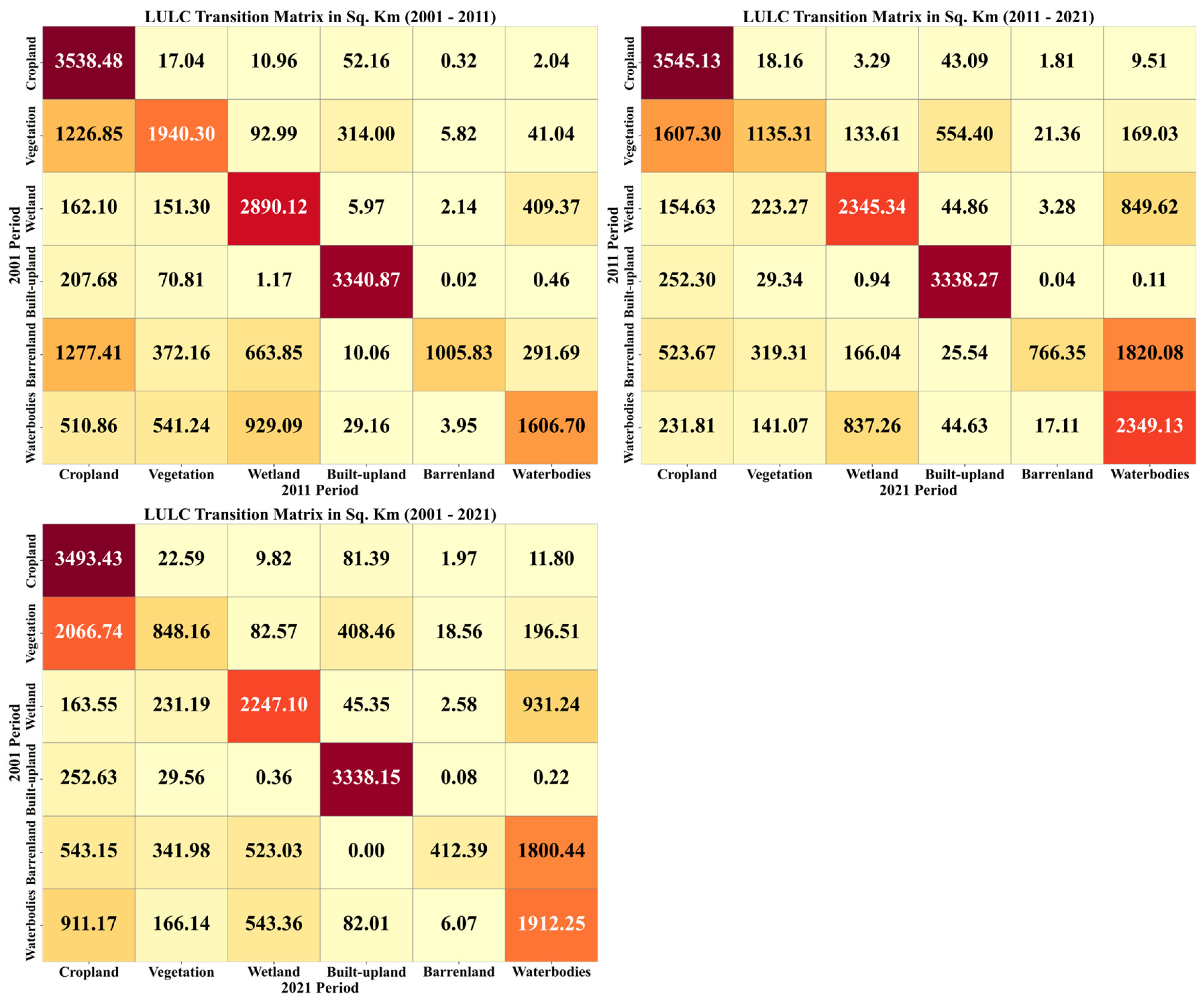




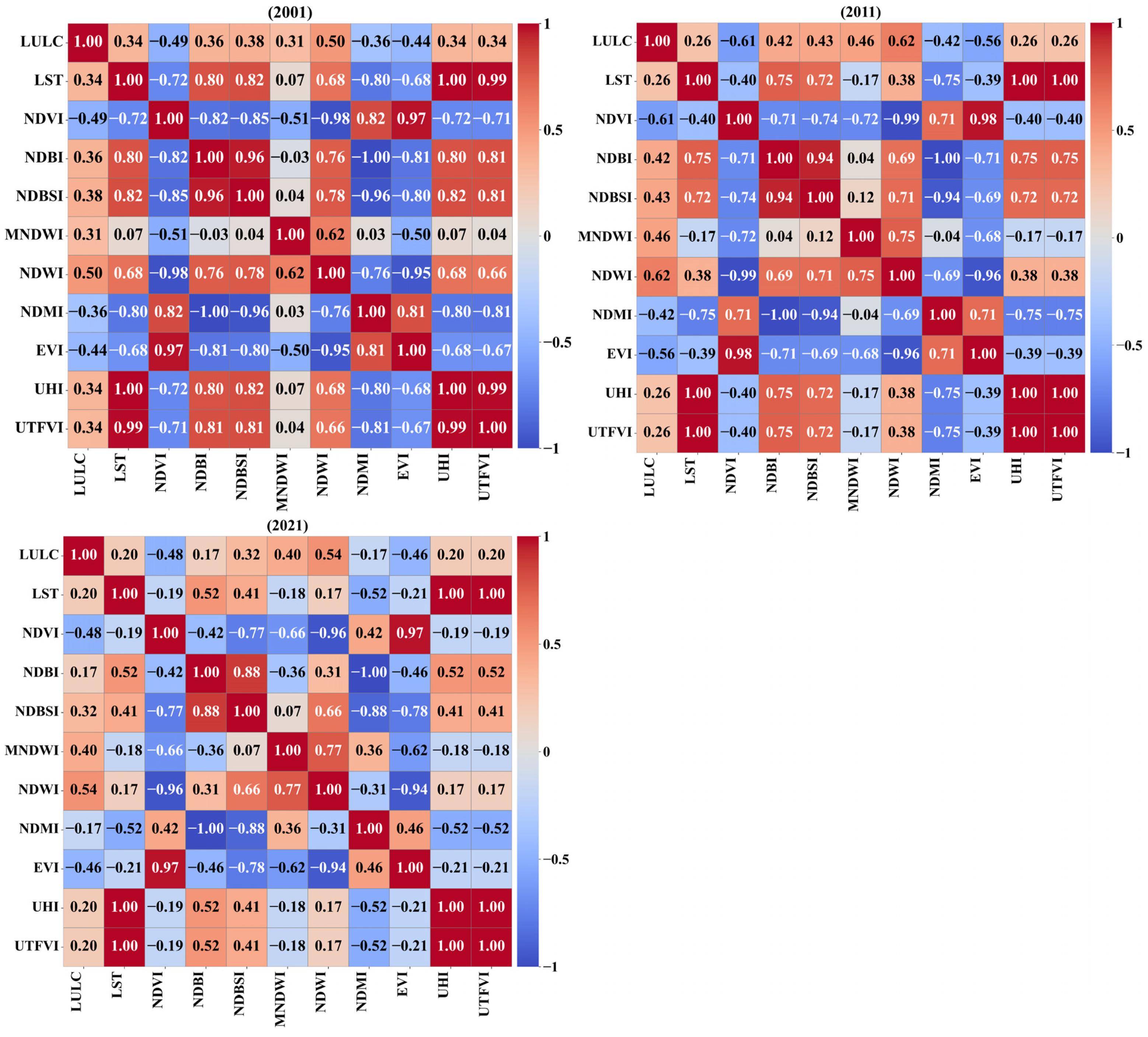
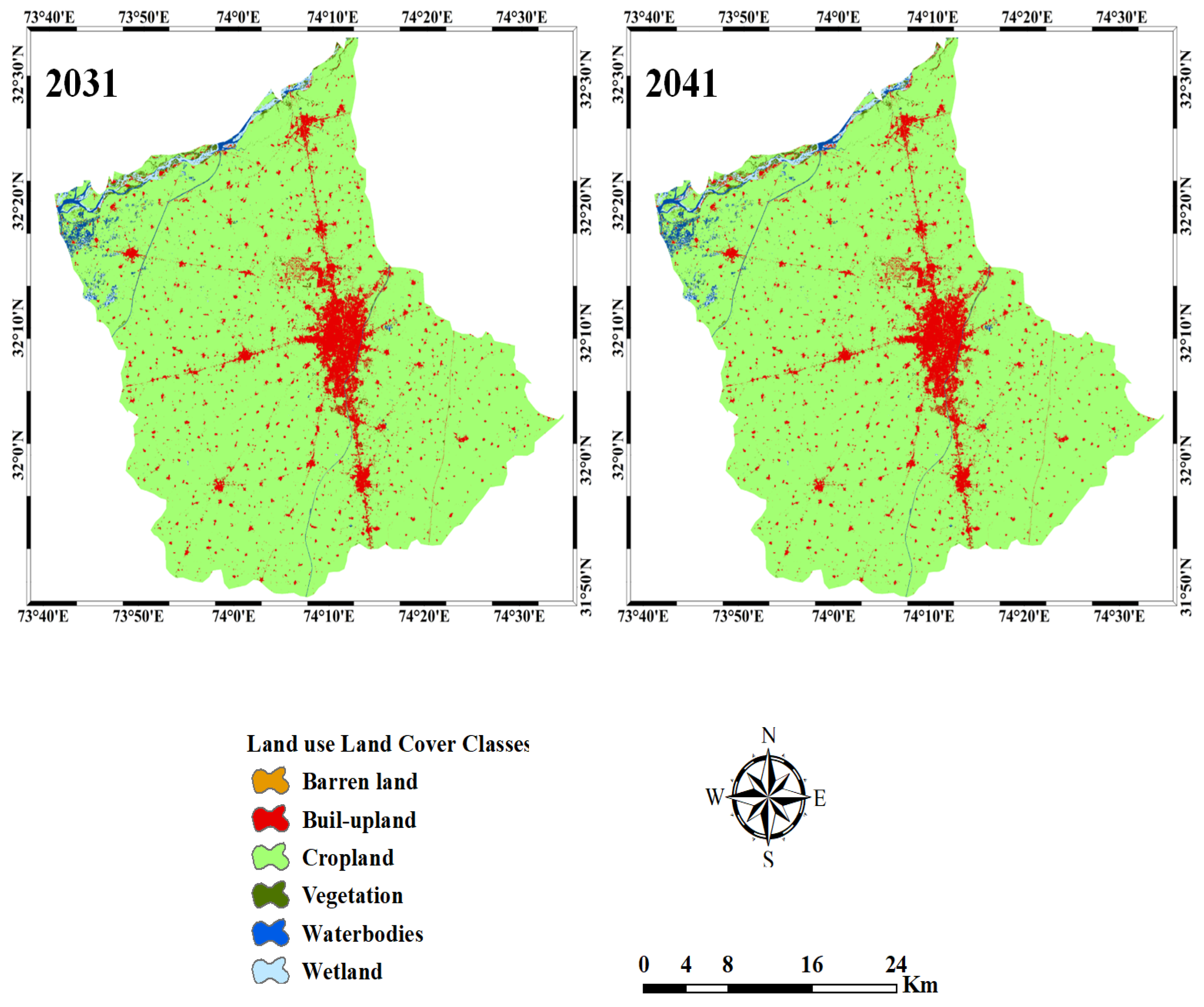
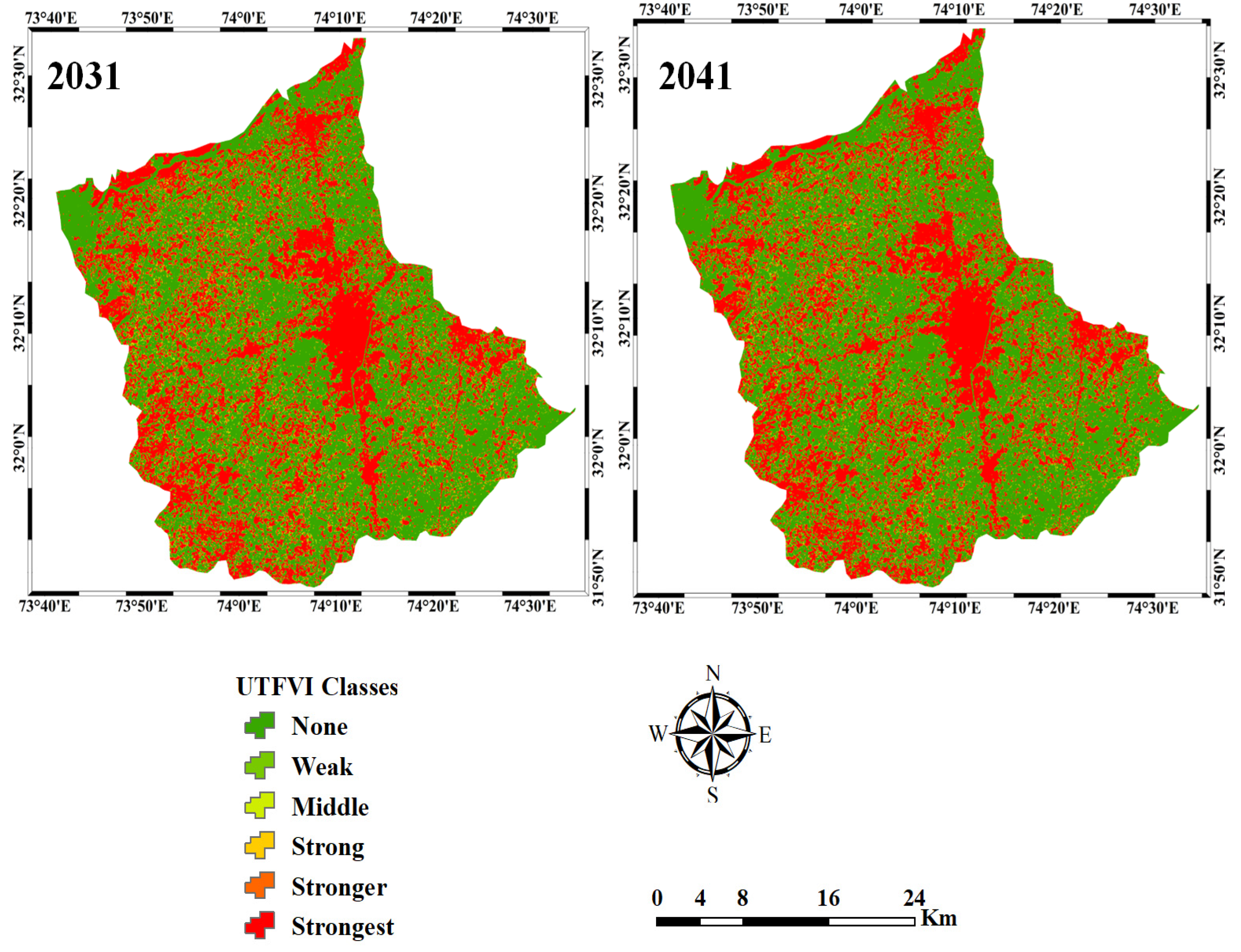

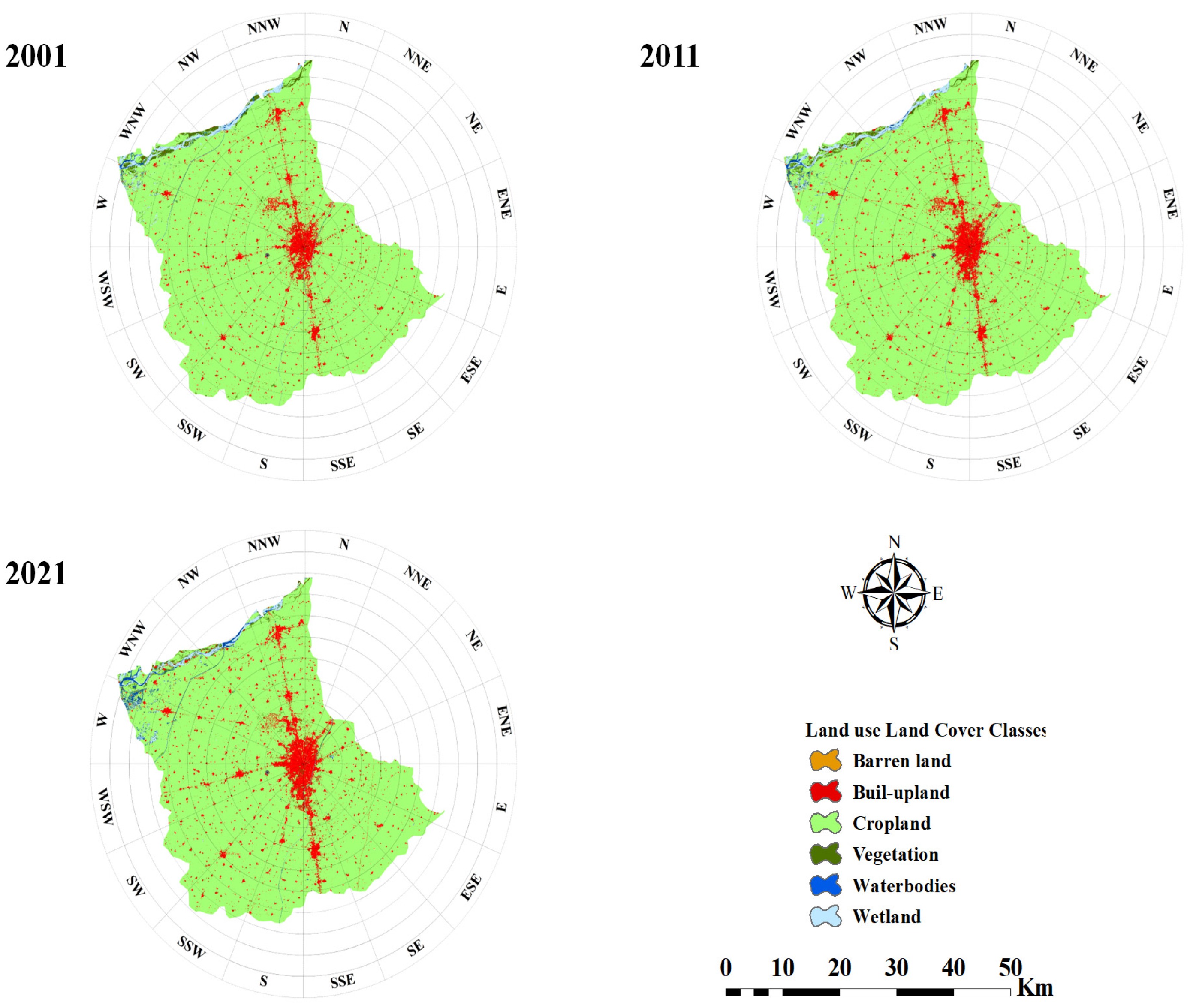
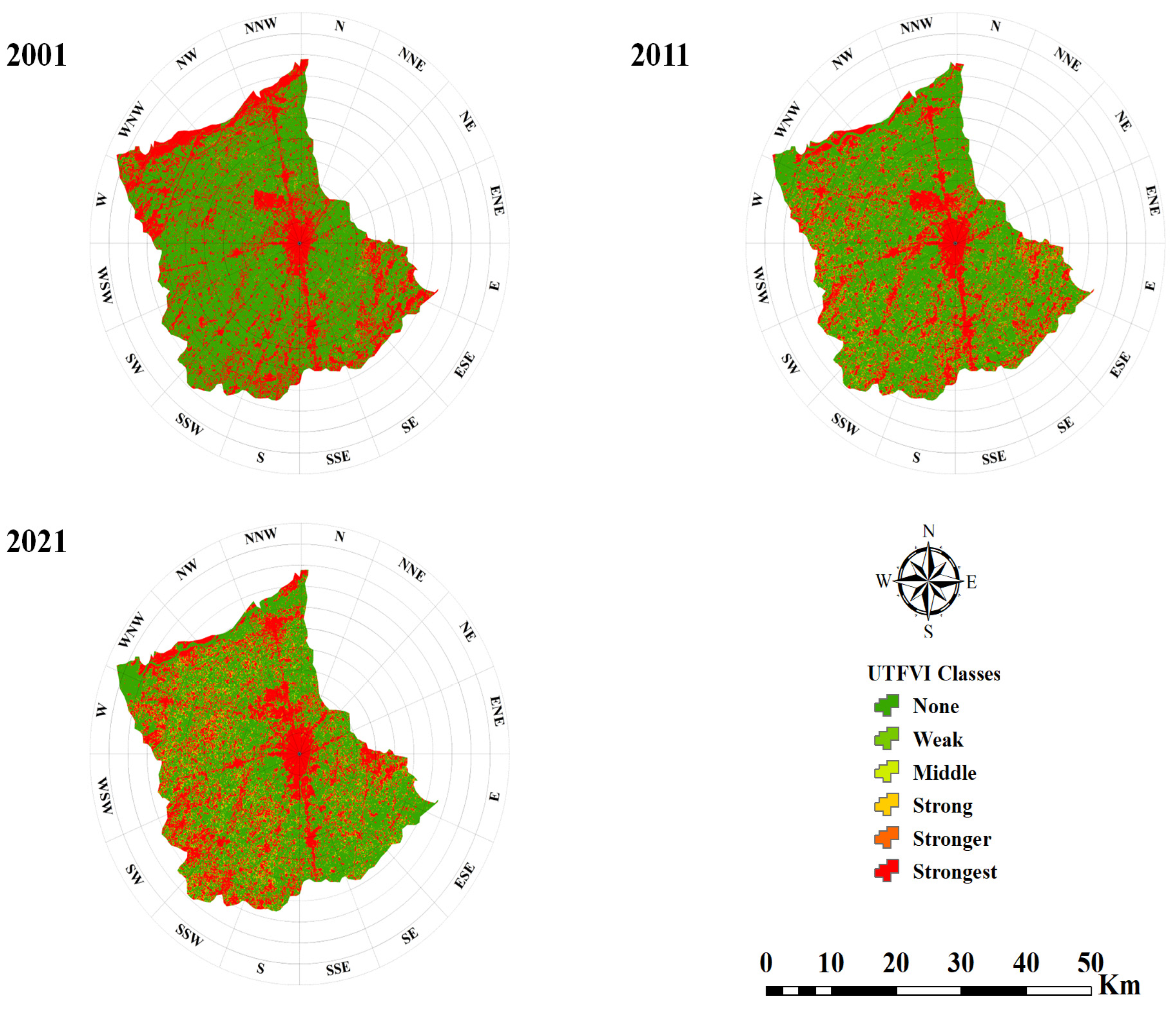
| Sr.No. | Year | Dataset | Sensor | Resolution | Cloud Cover | Source |
|---|---|---|---|---|---|---|
| 1 | 2001 | USGS Landsat 7 | ETM+ | 30 m | <10 | USGS/GEE |
| 2 | 2011 | USGS Landsat 5 | TM | 30 m | <10 | USGS/GEE |
| 3 | 2021 | USGS Landsat 8 | OLI/TIRS | 30 m | <10 | USGS/GEE |
| Sr.No. | Class |
|---|---|
| 1 | Cropland |
| 2 | Vegetation |
| 3 | Wetland |
| 4 | Built-up land |
| 5 | Barren land |
| 6 | Water bodies |
| UTFVI Classes | Range |
|---|---|
| None | <0 |
| Weak | 0–0.005 |
| Middle | 0.005–0.010 |
| Strong | 0.010–0.015 |
| Stronger | 0.015–0.020 |
| Strongest | >0.020 |
| LULC Classes | Area Change (km2 and %) | |||||
|---|---|---|---|---|---|---|
| 2001–2011 | 2011–2021 | 2001–2021 | ||||
| Δ Change | Δ Change | Δ Change | ||||
| km2 | % | km2 | % | km2 | % | |
| Cropland | −41.34 | −1.14 | −24.99 | −0.69 | −66.33 | −1.83 |
| Vegetation | −1.32 | −0.04 | −13.32 | −0.37 | −14.64 | −0.40 |
| Wetland | 3.75 | 0.10 | −11.60 | −0.32 | −7.85 | −0.22 |
| Built-up land | 36.31 | 1.00 | 28.58 | 0.79 | 64.89 | 1.79 |
| Barren land | 0.19 | 0.01 | 1.65 | 0.05 | 1.84 | 0.05 |
| Water bodies | 2.41 | 0.07 | 19.68 | 0.54 | 22.09 | 0.61 |
| UTFVI Classes | 2001–2011 | 2011–2021 | 2001–2021 | |||
|---|---|---|---|---|---|---|
| Δkm2 | Δ% | Δkm2 | Δ% | Δkm2 | Δ% | |
| None | −144.64 | −4.00 | −294.99 | −8.15 | −439.43 | −12.13 |
| Weak | 89.43 | 2.47 | 29.78 | 0.82 | 119.22 | 3.29 |
| Middle | 79.67 | 2.20 | 40.62 | 1.12 | 120.29 | 3.32 |
| Strong | 68.81 | 1.90 | 47.70 | 1.32 | 116.53 | 3.22 |
| Stronger | 59.25 | 1.64 | 49.28 | 1.36 | 108.55 | 3.00 |
| Strongest | −152.51 | −4.21 | 127.61 | 3.53 | −25.17 | −0.69 |
| LULC Classes | 2031 | 2041 | ||||||
|---|---|---|---|---|---|---|---|---|
| Area (km2) | % | Area (km2) | % | |||||
| km2 (2032) | Δ Changes (2021–2031) | % (2031) | Δ Changes (2021–2031) | km2 (2041) | Δ Changes (2031–2041) | % (2041) | Δ Changes (2031–2041) | |
| Cropland | 3223.51 | −8.99 | 89.00 | −0.25 | 3226.92 | 3.41 | 89.10 | 0.09 |
| Vegetation | 38.14 | −0.42 | 1.05 | −0.01 | 33.29 | −4.86 | 0.92 | −0.13 |
| Wetland | 37.04 | −7.00 | 1.02 | −0.19 | 33.32 | −3.72 | 0.92 | −0.10 |
| Built-up land | 281.70 | 9.98 | 7.78 | 0.28 | 285.03 | 3.33 | 7.87 | 0.09 |
| Barren land | 1.58 | −0.58 | 0.04 | −0.02 | 1.40 | −0.18 | 0.04 | −0.01 |
| Water bodies | 39.83 | 7.00 | 1.10 | 0.19 | 41.85 | 2.02 | 1.16 | 0.06 |
| UTFVI Classes | 2031 | 2041 | ||||||
|---|---|---|---|---|---|---|---|---|
| (km2) | % | (km2) | % | |||||
| km2 (2031) | Δ Changes (2021–2031) | % (2031) | Δ Changes (2021–2031) | km2 (2041) | Δ changes (2031–2041) | % (2041) | Δ Changes (2031–2041) | |
| None | 1925.73 | 80.01 | 53.17 | 2.21 | 1899.68 | −22.94 | 52.45 | −0.63 |
| Weak | 140.94 | −40.51 | 3.89 | −1.12 | 136.60 | 18.64 | 3.77 | 0.51 |
| Middle | 92.16 | −87.22 | 2.54 | −2.41 | 98.51 | −16.39 | 2.72 | −0.45 |
| Strong | 151.93 | −19.78 | 4.19 | −0.55 | 137.19 | 5.26 | 3.79 | 0.15 |
| Stronger | 161.34 | 1.33 | 4.45 | 0.04 | 139.46 | −3.16 | 3.85 | −0.09 |
| Strongest | 1149.69 | 66.16 | 31.74 | 1.83 | 1210.35 | 18.59 | 33.42 | 0.51 |
Disclaimer/Publisher’s Note: The statements, opinions and data contained in all publications are solely those of the individual author(s) and contributor(s) and not of MDPI and/or the editor(s). MDPI and/or the editor(s) disclaim responsibility for any injury to people or property resulting from any ideas, methods, instructions or products referred to in the content. |
© 2025 by the authors. Licensee MDPI, Basel, Switzerland. This article is an open access article distributed under the terms and conditions of the Creative Commons Attribution (CC BY) license (https://creativecommons.org/licenses/by/4.0/).
Share and Cite
Ullah, Z.; Mehmood, M.S.; Zhai, S.; Qin, Y. Analysis of LULC and Urban Thermal Variations in Industrial Cities Using Earth Observation Indices and Machine Learning: A Case Study of Gujranwala, Pakistan. Remote Sens. 2025, 17, 2474. https://doi.org/10.3390/rs17142474
Ullah Z, Mehmood MS, Zhai S, Qin Y. Analysis of LULC and Urban Thermal Variations in Industrial Cities Using Earth Observation Indices and Machine Learning: A Case Study of Gujranwala, Pakistan. Remote Sensing. 2025; 17(14):2474. https://doi.org/10.3390/rs17142474
Chicago/Turabian StyleUllah, Zabih, Muhammad Sajid Mehmood, Shiyan Zhai, and Yaochen Qin. 2025. "Analysis of LULC and Urban Thermal Variations in Industrial Cities Using Earth Observation Indices and Machine Learning: A Case Study of Gujranwala, Pakistan" Remote Sensing 17, no. 14: 2474. https://doi.org/10.3390/rs17142474
APA StyleUllah, Z., Mehmood, M. S., Zhai, S., & Qin, Y. (2025). Analysis of LULC and Urban Thermal Variations in Industrial Cities Using Earth Observation Indices and Machine Learning: A Case Study of Gujranwala, Pakistan. Remote Sensing, 17(14), 2474. https://doi.org/10.3390/rs17142474








